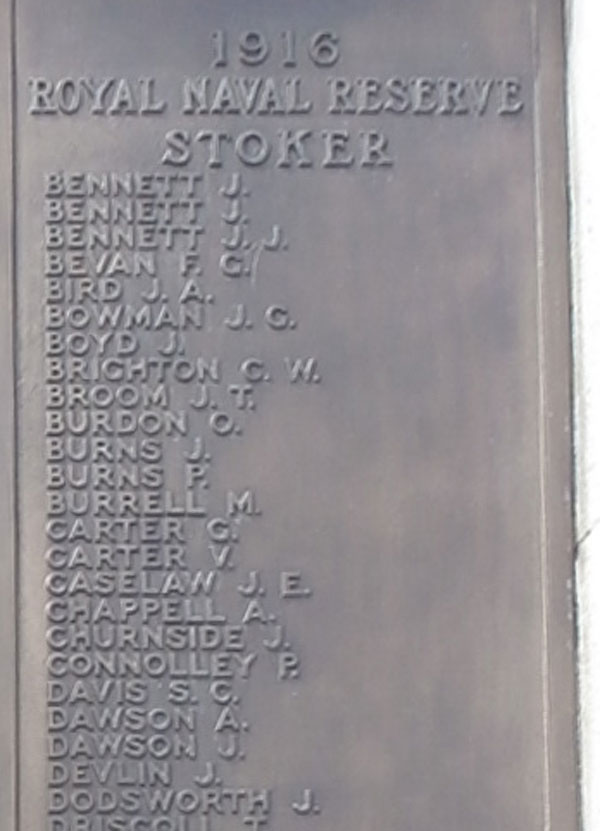| Date |
Information |
|
| 03/06/2024 |
 |
| 30/12/2015 |
643 sailors lost their lives with the sinking of the Hampshire, including Lord Kitchener, John Forrest and James Devlin. |
| 30/12/2015 |
Before joining the Royal Naval Reserve, James was employed in Iron Works at Port Clarence-on-Tees, where he had lived and worked for over 20 years. |
| 30/12/2015 |
Stoker Devlin was serving as a stoker on board HMS Hampshire and was lost at sea when the ship struck a mine off the Orkney Isles on 5th June 1916. |
| 30/12/2015 |
HMS Hampshire was a first class armored cruiser of the Devonshire class, with a weight of 10,850 tons and a length of 473ft 6 inches, with a beam of 68ft 6ins and a draught of 24 feet. It was powered by a two shaft, four cylinder engine, six boilers aft and 17 Yarrow water tube boilers distributed between the three forward boiler rooms. The ship could carry up to 1,950 tons of coal and had a maximum speed of 22 knots. To crew the ship it needed a full complement of 655 men. It was built at Chatham dockyard in Kent, between 1902 and 1904 with a cost of £900,000. The ship was commissioned in 1905. |
| 30/12/2015 |
The Hampshire had an eventful 11 years at sea, travelling to the Mediterranean and the Far East. The ship was involved in the hunt for the SMS Embden which was attacking Allied shipping at the start of World War 1 and took part in the Battle of Jutland. Hampshire was heavily armor plated and well equipped with 4x7.5in Guns, 6x6in Guns, 18-three pounders and 2x18in torpedo tubes. |
| 30/12/2015 |
At 4.40pm on Monday 5th June 1916, HMS Hampshire left Scapa Flow and took the route through Hoxa Sound to the south and then turned westwards into stormy weather just off south-west Hoy where it rendezvoused with the escort destroyers, HMS Victory and HMS Unity, the two destroyers then following behind the Hampshire. After failing to keep up to speed with the Hampshire over the next 2 hours both destroyers were signalled and asked to return to base. |
| 30/12/2015 |
At 7.40 pm, the Hampshire was struggling through a force 9 gale with an approximate speed of 13.5 knots between Marwick Head and the Brough of Bisray when the ship took an explosion after striking a mine which shook the whole vessel. The explosion ripped through the port side just forward of the bridge, with the helm jammed and the power cut the ship could not make radio contact with the authorities on shore to ask for assistance. |
| 30/12/2015 |
A telegraph message was sent from Bisray Post Office to Kirkwall and Stromness which read: |
| 30/12/2015 |
James Devlin was the son of John and Hannah Devlin, and brother of Michael John Devlin, Killeenan, Cookstown |
| 30/12/2015 |
By 7.50pm within minutes of striking the mine, HMS Hampshire began to sink. She went down, bows first and leaning to the starboard side. |
| 30/12/2015 |
James Devlin is commemorated on Chatham Naval Memorial, Kent, England. |
| 30/12/2015 |
 |
| 30/12/2015 |
From the Mid Ulster Mail dated Saturday 24th June 1916: Stoker James Devlin |
| 30/12/2015 |
 |
| 30/12/2015 |
Mr Michael John Devlin, of Killeenan, has received intimation that his only brother, Stoker James Devlin, was one of the crew of H.M.S. Hampshire, which went down at the Orkneys with Lord Kitchener and staff. The deceased was employed at iron works at Port Clarence-on-Tees, where he had been for over twenty years. At the outbreak of war, like so many other Irish in England, he volunteered and joined the Navy. |
| 30/12/2015 |
The CWGC record Stoker James Devlin as the son of John and Hannah Devlin, of Killeenan, Cookstown, Co. Tyrone. |
| 30/12/2015 |
 |
| 30/12/2015 |
Lord Kitchener was immortalised in the World War One recruiting poster |
| 30/12/2015 |
“Battle cruiser seems in distress between Marwick Head and Brough of Bisray.” |